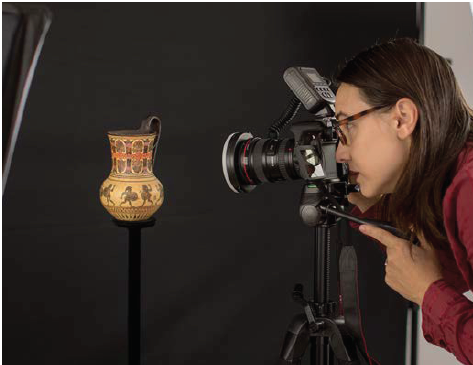The pictures are then processed and the 3D model is cleaned up before it can be used.



An instructor is taking pictures of an object in our newly developed Photogrammetry course.
Left and above are pictures of our new full motion capture studio.


The project's objectives:
Host a Job Task Analysis (JTA) to create rigorous, project-based courses in operation, utilization, and programming using highly technical hardware and software.
Place faculty in industry externships to improve and update their skills and abilities, allowing them to share real-world experience with students.
Create four new courses as part of two new certificate programs.
Build a training studio for motion capture and photogrammetry. The studio will incorporate multiple stationary cameras around a moving object covered in data-capturing "dots" to convert data into 3D animations. It will also use data from multiple 2-D photographs of a stationary object at different angles to create three-dimensional output. This studio will provide students with hands-on, industry-valued skills and experience.
Incorporate components such as work-based learning/job shadowing, industry tours, and employability-skills practice throughout the program.
Increase diversity across the entire program through targeted, evidence-based practices aimed at recruiting and retaining higher percentages of students from populations, such as women and veterans, that are under-represented in STEM technical fields.
Utilize external formative and summative evaluation to monitor project success and make iterative programmatic improvements. Descriptive statistics and inferential statistics will be utilized as a part of the evaluation. Data will be collected and analyzed to determine annually whether the stated outcomes have been met. In addition, the evaluation and project teams will provide annual reports on relevant quantitative measures of project success based upon enrollment, certificate completion, industry placement, degrees earned, and pass rates for the four new courses.
The project's goal is 200 students will enroll in the four new courses over the course of the project. Additional students will benefit from the increased industry involvement in technician education programs, including studio tours, mock interviews, and portfolio presentations.
The National Science Foundation's Advanced Technological Education (ATE) program has been funding innovation at two-year colleges for over twenty years. With a focus on the education of technicians for the high-technology fields that drive our nation's economy, and strong partnerships between academic institutions and industry, ATE promotes improvement in the education of science and engineering technicians at the undergraduate and secondary school levels.
To learn more about ATE, please visit the NSF ATE program home page.
To read the Award Abstract # 1902466, please visit the NSF award page.
Wake Tech's Simulation and Game Development program provides students with a broad background in the simulation and video game industry. The curriculum includes practical applications in creative arts, visual arts, audio/video technology, modeling, animation, design, programming, and management.
We offer two degrees: Art & Modeling and Programming.
To learn more about our program, please visit the Wake Tech's SGD webpage.
This award will support development of certificate programs in Technical Art & Photogrammetry and in Technical Animation. The project goal is to train technicians who have the critical knowledge and skills in art and programming that are needed for the design and development of realistic simulations for virtual and augmented reality. The project has significant industry involvement to ensure that both faculty and students gain industry-relevant experience, and to ensure that students who earn the certificates are fully prepared to enter the workforce. The project addresses the need to develop technicians with the ability to produce the sophisticated user interfaces, simulations, and training systems demanded by the future of work in a broad array of fields, including education, medicine, law enforcement, and engineering.